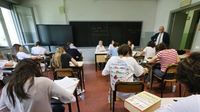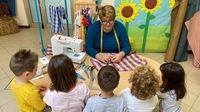Brescia is facing a significant demographic decline, with projections indicating that by 2040, the number of students enrolled in high schools will decrease by 18,000, marking a staggering 26% drop. This alarming trend is attributed to a combination of declining birth rates and reduced migration flows, which have left local officials scrambling to address the potential social and economic repercussions.
Agostino Damiolini, a provincial councilor responsible for school construction, highlighted the gravity of the situation, noting that half of the region's youth express a willingness to relocate abroad. "This explosive mix impacts our social and labor fabric," he stated, underscoring the urgency of the issue.
In light of these challenges, the Province is investing 70 million euros, primarily from Pnrr funds, to enhance and modernize school facilities. The aim is to make these buildings more earthquake-resistant and to provide modern gymnasiums. However, Damiolini pointed out that in just over a decade, the region will need 600 fewer classrooms, raising questions about sustainable property management.
Despite the pressing need for solutions, Fabio Rolfi, vice president of Broletto, clarified that there are currently no discussions regarding school closures or mergers. Yet, he acknowledged the reality that the municipalities must confront. The options are limited: either transform school buildings into multifunctional centers akin to those in Northern Europe—combining libraries, community centers, and other cultural services—or face the prospect of closing some structures.
Currently, Brescia's high schools serve 51,000 students, with an additional 9,000 enrolled in vocational training centers and 4,400 in private institutions, totaling 65,000 students. However, this figure is expected to stabilize for a couple of years before beginning to decline. Damiolini noted that overall enrollment across all education levels has decreased from 151,000 in 2021 to 143,000 in the past year, a loss of 7,000 students, primarily in early childhood and private schools.
As the demographic winter continues to take its toll, the implications extend beyond education. Rolfi raised concerns about public transportation, questioning the feasibility of maintaining bus routes to high schools with dwindling enrollments. "Does it make sense to imagine that in ten years, buses will continue to transport students to high schools with 200 enrollments when a nearby school has 1,200?" he asked.
In the broader context, Brescia is not alone in facing these challenges. The region's municipalities with the lowest student enrollments—such as Pisogne (175), Lumezzane (196), Gardone Riviera (291), and Orzivecchi (336)—are particularly at risk as they struggle to maintain viable educational facilities.
Meanwhile, in Florence, the situation mirrors that of Brescia, with schools bracing for a reduction of 1,510 students in the upcoming academic year. This decline is compounded by a government decision to cut 105 teaching positions in Florence and 375 across Tuscany, a move that has raised alarms among educators and unions.
Pasquale Cuomo, the regional secretary of Flc Cgil, expressed his concern, stating, "The budget law has established a cut of over 5,000 teachers nationally. This governmental decision coincides with the demographic decline, which will hit smaller provinces the hardest. We will therefore see a significant reduction in contracts for temporary teachers, which the ministry will continue to avoid stabilizing to maintain a flexible pool of educators based on need."
Cuomo's remarks reflect a growing frustration within the educational community, as the cuts threaten to exacerbate existing challenges, particularly in ensuring safety and cleanliness in schools, especially at the early childhood and primary levels.
The analysis of the enrollment figures reveals that the primary schools will see the most significant drop, with 1,138 fewer children expected. Middle schools will experience a decrease of 223 students, while kindergartens will lose 84 students. The high school sector, however, will only see a minor reduction of 65 students, indicating that the impact of declining birth rates is felt most acutely in earlier education stages.
Claudio Gaudio, provincial secretary of Cisl Scuola, suggested that the demographic decline could be reframed as an opportunity to address the long-standing issue of overcrowded classrooms. "This undeniable demographic winter could be transformed into an opportunity if there were the political will to tackle the chronic problem of overcrowded classes," he asserted. However, he cautioned that this would require a shift in policy to avoid proportional cuts to teaching staff in line with declining student numbers.
Currently, primary school classes range from 15 to 26 students, while middle school classes have between 18 and 27 students, with some reaching up to 30. High school classes range from a minimum of 27 to a maximum of 30 students. As the education sector grapples with these challenges, unions continue to advocate for more sustainable class sizes to facilitate higher quality teaching.
The upcoming weeks will reveal how the 105 teaching positions will be allocated across various educational levels, with calls from educators to minimize impacts on early childhood and primary education, which require particular attention and resources.
As Brescia and Florence navigate these turbulent demographic waters, the need for innovative solutions and proactive policies has never been more urgent. The future of education in these regions depends on the ability to adapt to changing demographics while ensuring that quality education remains accessible to all students.





